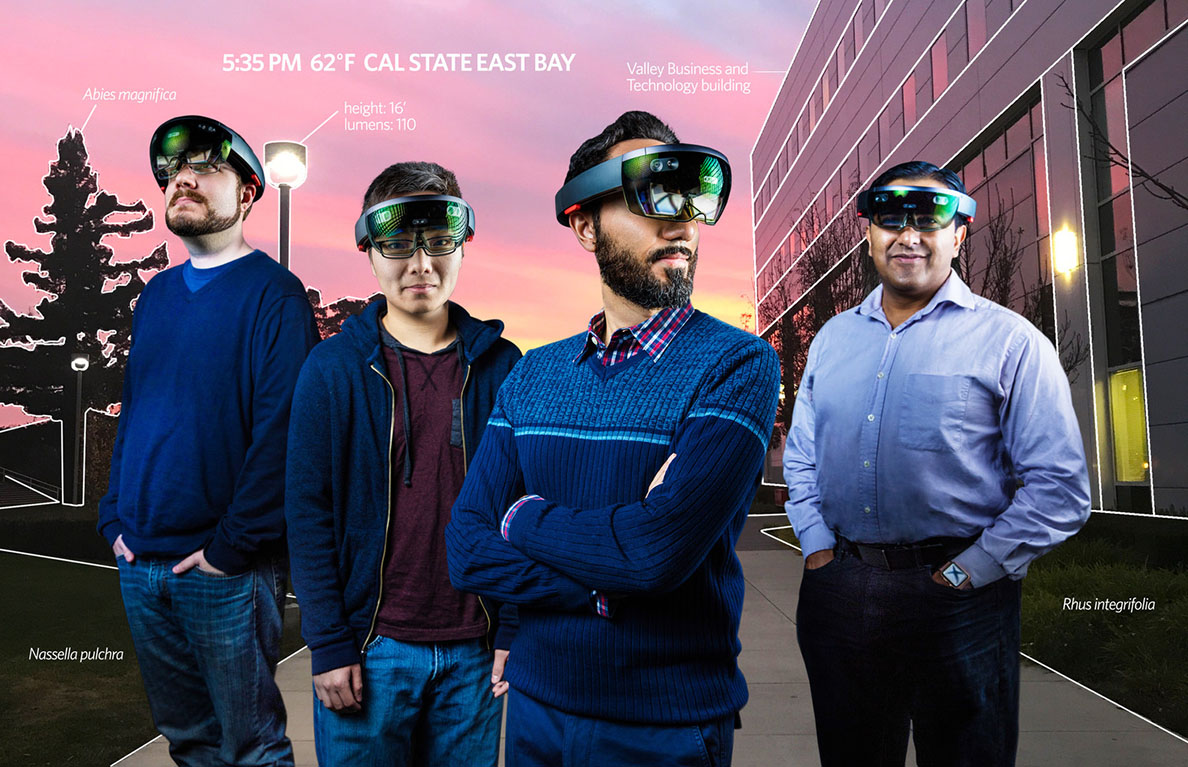
Augmented reality
- BY DAN FOST
- PHOTOGRAPHY BY GARVIN TSO
- March 15, 2018
Slip on the goggles in Professor Ehsan Kamalinejad’s office, and a hologram of a wrestler, tattoos and all, appears on the desk. The wrestler, of course, is a 3-D hologram and not a real person, but the device used to create it may hold the key to helping the visually impaired better experience the world around them.
The goggles are the latest teaching and research device in Kamalinejad’s toolbox and are preparing students for careers in a rapidly expanding field: augmented reality.
Unlike virtual reality, which creates an entirely artificial world for the user to navigate, augmented reality gives users an overlay of information on top of the real world. (Think Pokemon Go.) According to TechTimes.com, with AR, users can not only distinguish between the virtual and real worlds, but they are also able to interact with both at the same time.
“We’re interested in solving problems in machine learning and visualization.”
In theory, this means that someone who is visually impaired, for example, could wear the goggles while walking through the Cal State East Bay campus and be informed of various obstacles or objects beyond their field of vision. And that’s exactly what Kamalinejad and his team of advanced mathematics students are using the goggles to research.
NOT JUST A TOOL
Kamalinejad won a grant last year to get the coveted Microsoft HoloLens goggles, still in beta and unavailable to the general public. This quarter they are using advanced mathematics principles to push the technology forward and contribute to a larger body of research currently being done about artificial intelligence and its applications in everyday life.
“The goggles are just a tool for us,” Kamalinejad said. “We’re interested in solving problems in machine learning and visualization.”
Just a tool? Perhaps, but one Kamalinejad knows can do more with the right research.
“We wanted to find out where the industry is and then go further,” he said. “We want to use the depth perception on these goggles to do object recognition … a simple human activity, one most of us take for granted. When you’re walking, you know what a tree is. You know what a pedestrian is. Can we teach computers to reach the same automatic, split-second conclusions?”
If Kamalinejad and the students discover the answer is ‘yes,’ the possibilities are endless. Sensors similar to those found in the HoloLens goggles already enable self-driving cars to stop before striking something in the road. With a bit more research and programming, they could help the visually impaired complete everyday tasks such as navigating city streets.
Kamalinejad, who came to Cal State East Bay five years ago after earning his Ph.D. at the University of Toronto, received an Academic Access, Enhancement and Excellence grant from the university to acquire the headset — touted as “the first self-contained, holographic computer.”
“You can’t even buy it directly,” Kamalinejad says. “You have to tell Microsoft about your application and why you deserve to have one, and they then sell you one for $3,000.”
CHALLENGING, BUT CRUCIAL
Along with his A2E2 grant for $68,000, Kamalinejad and computer science assistant professor Jaiofei Zhong received a $35,000 National Science Foundation grant to support the HoloLens research.
Students came to the project from different backgrounds. Andrew Kim was a math student, while Kelby Madal-Hellmuth had taken classes in artificial intelligence. Both seniors applied to be part of Kamalinejad’s project and were among the four chosen to participate.
Last summer, Kamalinejad and the team went to Fresno to present at an augmented reality conference and spent 10 weeks working on coding challenges and reading research surrounding augmented reality.
“It’s not a question of when, but a question of when it happens, what do we do about it?”
“The ‘back propagation’ problem took us forever,” Madal-Hellmuth recalls. “That’s the algorithm that makes deep learning possible. Conceptually, it’s not that difficult, but programming it was a pain … If you get one thing wrong, the whole thing is wrong, and it’s very difficult to de-bug.”
The work was challenging, but crucial to the students’ future career paths.
The number of active virtual reality users worldwide is predicted to reach 170 million by the end of this year, according to Statista.com, and the market of VR and AR software is expected to see an increase of over 3,000 percent in the next few years.
As for the concerns of artificial intelligence taking human jobs and running our lives? Kamalinejad acknowledges the changes wrought by AI may be more significant than those brough about by the Industrial Revolution but says AI is merely another tool in humans’ toolboxes.
“It’s not a question of when, but a question of when it happens, what do we do about it?” he says.